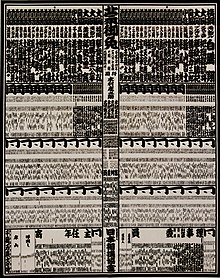
Sumo is a form of competitive full-contact wrestling where a rikishi (wrestler) attempts to force his opponent out of a circular ring (dohyō) or into touching the ground with any body part other than the soles of his feet.
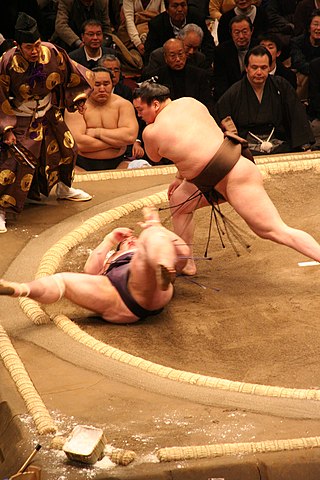
Makuuchi (幕内), or makunouchi (幕の内), is the top division of the six divisions of professional sumo. Its size is fixed at 42 wrestlers (rikishi), ordered into five ranks according to their ability as defined by their performance in previous tournaments.
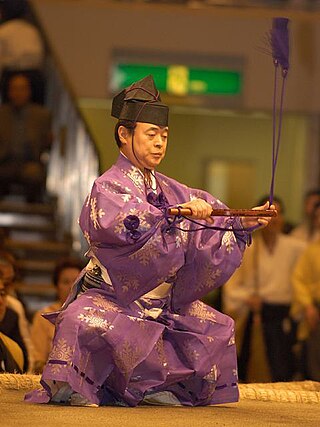
A gyōji is a referee employed by the Japan Sumo Association, responsible for a variety of activities which concern the organisation of the sport in general and the refereeing of matches, as well as the preservation of professional sumo culture, deeply rooted in Shinto traditions. Subject to the same strict hierarchy and traditional appearance as the other professions gravitating around professional sumo, the gyōji are one of the most visible professions at tournaments, being the third person in the dohyō and sometimes defined as "an essential part of the sumo spectacle."

A yobidashi, often translated in English as "usher", "ring attendant", or "ring announcer", is an employee of the Japan Sumo Association, responsible for various tasks essential to the traditional running of professional sumo tournaments in Japan. The yobidashi are involved in building the dohyō or calling wrestlers to the ring when it is their turn to fight. They are also entrusted with other roles, both administrative and artistic, in the service of the stable to which they are attached.

A honbasho, or Grand Sumo Tournament in English, is an official professional sumo tournament. Only honbasho results matter in determining promotion and relegation for rikishi on the banzuke ranking. The number of honbasho held every year and their length has varied; since 1958 there are six tournaments held over 15 consecutive days in four locations every year. Since 1926 the honbasho are organized by the Japan Sumo Association, after the merger of the Tokyo and Osaka sumo associations.
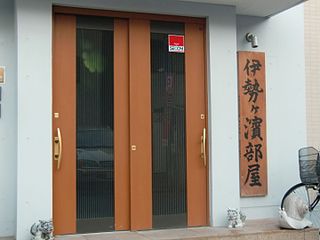
Isegahama stable, formerly known as Ajigawa stable from 1979 to 2007, is a stable of sumo wrestlers, part of the Isegahama ichimon or group of stables. Its current head coach is former yokozuna Asahifuji.

Kakizoe Tōru, is a former sumo wrestler. A former amateur champion, he turned professional in 2001 and reached the top division in 2003. His highest rank was komusubi, which he held for just one tournament. He won one special prize, for Technique. After injury problems he fell to the third makushita division in 2011 and retired in April 2012, becoming a sumo coach. He was part of ex-yokozuna Musashimaru's Musashigawa stable from 2013 until 2020, when he moved to Irumagawa stable. He is now a sumo elder, under the name Ikazuchi (雷).
Professional sumo as administered by the Japan Sumo Association is divided into six ranked divisions. Wrestlers are promoted and demoted within and between these divisions based on the merit of their win–loss records in official tournaments. For more information see kachi-koshi and make-koshi. Wrestlers are also ranked within each division. The higher a wrestler's rank within a division is, the stronger the general level of opponents he will have to face becomes. According to tradition, each rank is further subdivided into East and West, with East being slightly more prestigious, and ranked slightly higher than its West counterpart. The divisions, ranked in order of hierarchy from highest to lowest, are as follows:
The following words are terms used in sumo wrestling in Japan.

Sadogatake stable is a stable of sumo wrestlers, one of the Nishonoseki group of stables. In its modern form, it dates from September 1955, when it was set up by former komusubi Kotonishiki Noboru. Former yokozuna Kotozakura took over the running of the stable in 1974 following Kotonishiki's death. The stable is located in Matsudo, Chiba prefecture. Over the next thirty years the stable produced a string of top division wrestlers. Kotozakura stood down in November 2005, handing the stable over to his son-in-law, former sekiwake Kotonowaka.

Kasugano stable is a stable of sumo wrestlers, part of the Dewanoumi ichimon or group of stables. As of January 2023 it had 17 wrestlers. It has been led by former sekiwake Tochinowaka Kiyotaka since 2003. It was one of the most successful stables in 2013, with six sekitori wrestlers, including now retired Georgian Tochinoshin and Japanese born Tochinowaka Michihiro, who used the current head coach's old ring name.
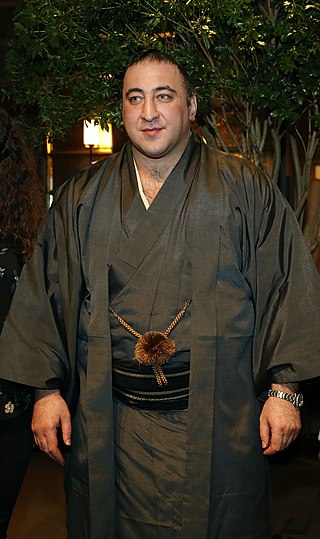
Tochinoshin Tsuyoshi is a Georgian former professional sumo wrestler from Mtskheta. He was a member of the Kasugano stable and made his professional debut in March 2006. He reached the top makuuchi division just two years later in May 2008. After a long hiatus due to injury, he began his comeback from the rank of makushita 55 in March 2014, logging four championships in a row in lower divisions on his way back to the top division in November 2014. In January 2018 he took his first and only top-division championship. In May 2018, after finishing as runner-up with a 13–2 record and a total of 37 wins in his last three tournaments, he was promoted to ōzeki. He received eleven special prizes, six for Fighting Spirit, three for Technique, and two for Outstanding Performance, as well as two kinboshi for defeating yokozuna. Tochinoshin was demoted to sekiwake after posting losing records in the first two tournaments of 2019, but returned to ōzeki after winning ten matches at the May 2019 tournament. He lost the ōzeki rank again after the September 2019 tournament, and lost his top division status after he was sidelined with a shoulder injury during the January 2023 tournament. He retired from sumo on 19 May 2023.

Kagamiō Hideoki is a former Mongolian-born professional sumo wrestler from Ulaanbaatar. He made his debut in July 2003 for Kagamiyama stable. He reached the jūryō division in January 2013 and the top makuuchi division a year after that. His highest rank was maegashira 9. Following a long-term injury layoff he fell off the banzuke or ranking sheets in 2021. In March 2023 he obtained Japanese citizenship.
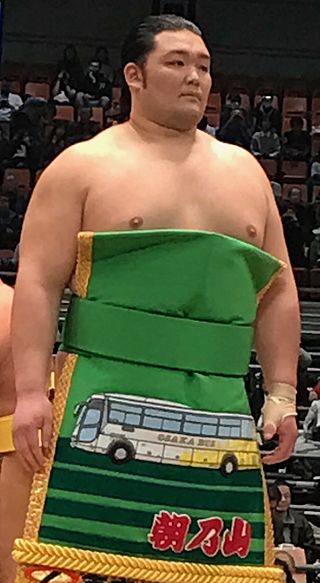
Asanoyama Hiroki is a Japanese professional sumo wrestler from Toyama Prefecture. He wrestles for Takasago stable. He debuted in sumo in March 2016 and made his makuuchi debut in September 2017. His highest rank has been ōzeki. He has earned six special prizes, and one gold star for defeating a yokozuna. In May 2019 he won his first top division yūshō or tournament championship, the first of the Reiwa era. He was also runner-up in November 2019 and finished the calendar year with more top division wins than any other wrestler. He was promoted to ōzeki after the March 2020 tournament, and was a runner-up in his ōzeki debut in July 2020 and in January 2021.

Kyokutaisei Takuya is a Japanese professional sumo wrestler from Asahikawa, Hokkaido. His debut in maezumō was in January 2008, and his first makuuchi division honbasho was the Natsu tournament in May 2018. His highest rank has been maegashira 8. He has one special prize for Fighting Spirit. He is a member of Ōshima stable.

Daishōhō Kiyohiro is a Mongolian professional sumo wrestler from Ulaanbaatar. He began his professional sumo career in 2013 at the age of eighteen. His highest rank to date has been maegashira 9. He wrestles for the Oitekaze stable.

Meisei Chikara is a Japanese professional sumo wrestler from Setouchi, Kagoshima. He debuted in sumo wrestling in July 2011 and made his makuuchi debut in July 2018. His highest rank has been sekiwake. He wrestles for Tatsunami stable. Unusually for a top-class sumo wrestler, he uses his given name as his shikona.

Kotozakura Masakatsu, born 19 November 1997 as Masakatsu Kamatani, is a Japanese professional sumo wrestler from Chiba Prefecture. He wrestles for Sadogatake stable, a sumo stable previously run by his grandfather, former yokozuna Kotozakura, and currently run by his father, former sekiwake Kotonowaka. He made his debut in November 2015 and reached the top makuuchi division in March 2020, reaching the san'yaku ranks in January 2023. His highest rank has been ōzeki. During his career he has won five special prizes for Fighting Spirit, as well as one Technique prize.
The following are the events in professional sumo during 2022.
The following are the events in professional sumo during 2023.
